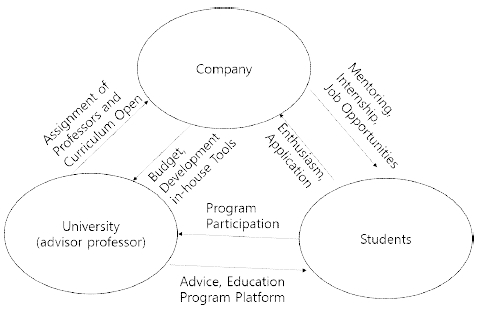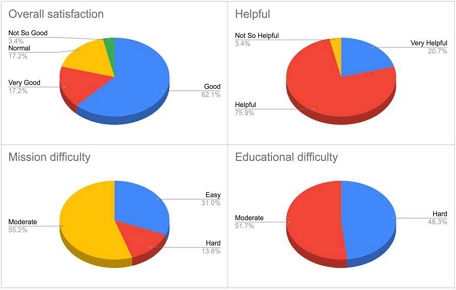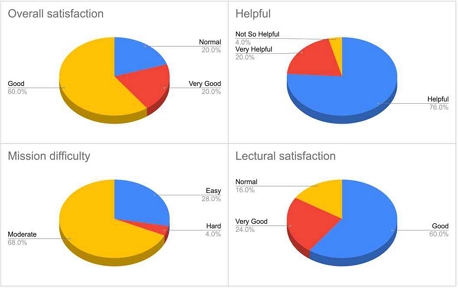
A Case Study of Industry Demand-Driven Computer Science College Education Through Industry-Academia Collaboration Directly Addressing Corporate Demands
Abstract
In this paper, we present a case study of college education in the area of computer science through industry-academia collaboration. In 2019, University ‘A’ made an agreement with a global company 'B' for industry-academia co-research projects and human resource exchange for mutual benefit. Since 2020, based on the agreements with company 'B', we provided students with a series of education programs focusing on the company's field demands, especially mobile service implementation and application development planning using the company's in-house development low-coding tool chain. The program consists of a training, mentoring, competition, and internship courses for hiring. We continuously improved the program details year-by-year accumulating the result. As a result of three-years program running, we were able to successfully secure employment for eight students at company 'B'. We believe that the successful case of industry-academia collaboration in software educational field can provide a new guidance for securing stable, high-quality talent for companies.
Keywords:
Computer Education, Industry-Academia Collaboration, Education focusing on Industry-Demands, Field-Oriented Software Education1. Introduction and Background
1.1 Background
Students worry about finding jobs, universities strive for educational innovation, and companies seek to hire excellent talents—these are the realities that many face today[1].
An integrated approach to addressing these concerns is through industry-academia collaboration, specifically through customized employment-linked education programs based on industry demand. Such programs not only provide students with relevant skills and improved job prospects but also help universities align their curricula with industry needs and enable companies to access a pool of well-prepared candidates.
Basically, industry-academia collaboration efforts and strategies to secure skilled personnel can be classified into several types as follows: First and most common type is talent acquisition based on collaborative research project[2][3]. Collaboration on joint research projects allows companies to identify and attract talented individuals who can contribute to their innovation and growth, while also providing students with practical, hands-on experience. This research-entered collaboration model cannot be applied to education-centered small universities and small and mid-sized companies.
Another type is developing large-scale industry-academia collaboration project driven by governmental support[4][5]. This model usually develops company-specific curriculum or establish special education tracks by school regular organization. : Universities tailor their courses to meet the needs of industry partners, ensuring that students gain the skills and knowledge that are in high demand. The limitation of this type of collaboration is the prerequisites of huge amount of budgets and human resources to be involved[6].
The other approach involves the creation of special educational programs that are extra-curricular, voluntarily established through collaboration between colleges and companies[7][8]. Often, these programs are not as well-structured and may face challenges in maintaining sustainable operations.
Each of these strategies has its own merits and can be part of a comprehensive approach to bridging the gap between education and employment, thereby benefiting students, universities, and companies alike.
The models mentioned above have their respective limitations. Some models are more appropriate for research universities, while other models require significant effort to restructure the regular curriculum and school structure and substantial budgets and human resources from companies for continuous operation. These can be challenging for small and medium-sized enterprises to adopt without a certain level of student participation.
This paper proposes a new model of educational industry-academia collaboration that is tailored for software small and mid-sized companies or start-ups. The model aims to maximize the efficiency of discovering excellent, company-specific talents while keeping corporate investments at an optimal level. We present a sustainable and practical approach to collaboration that leverages the strengths of both educational institutions and companies without the heavy investment typically associated with traditional industry-academia partnerships between large-sized companies and big universities. This model seeks to provide a balanced, flexible framework that benefits all parties involved, ensuring the continuous flow of skilled talents into the industry while enhancing the relevance and quality of university’s educational programs.
1.2 The Key Features and Benefits of Our Program Model
The key elements of this model include:
1) Education Content and Financial Support: Small and medium-sized enterprises that require new employees provide educational content relevant to their industry and contribute operational funds. In addition, the professors involving the program also contribute enhancing the learning material with the engineers of the company.
2) Dedicated Professors: Universities offer administrative support by allocating committed professors to manage and operate the program. This support ensures that the educational program is integrated seamlessly into the university's curriculum and is delivered effectively.
3) Robust Mutual Trust Between Companies and Universities: Company contribute funds with the trust that their donations will be exclusively used for developing talent beneficial to their workforce. On the other side, universities anticipate continuous interest and support from these companies, trusting that they maintain an excellent corporate culture that makes them desirable workplaces for students.
For the program's operation under this model, Company ‘B’ annually donates a fixed amount of operational funds and its software development tools to the university. The university, through a dedicated professor, runs a pre-education and competition program over several months, including summer break periods. The development framework provided by the company is an app development tool based on low-coding technology, allowing students with basic knowledge of computer programming to start easily. The learning materials are well-prepared and structured to facilitate easy understanding and engagement.
Each year, an average of more than 10 teams participate in the competition, which is attended online by executives and representatives of the Company ‘B’. During the event, teams present their projects, and an award ceremony is held. Outstanding teams from the competition are offered internships at Company B, with the possibility of receiving a full-time job offer upon completion of their internship, allowing them to transition smoothly from education to employment.
The advantages and success secrets of the program are as follows:
First advantages of the proposed program is its high efficiency, stemming from its focus on students specifically interested in the company. This targeted approach likely results in higher retention rates, more effective learning outcomes, and a smoother transition into employment. Furthermore, students who are interested in the company are more likely to be committed to the training, and enthusiastic about the prospect of working there, which can lead to better job performance and higher satisfaction levels.
Second advantage of the proposed program is that it facilitates student recruitment by lowering the entry barriers to the program. This approach makes the program more accessible to a broader range of students, including those who might not have considered participating due to their background is not science and engineering.
Third advantage of the program is the ease of finding students who are well-suited to the company's needs. This is largely due to the program's emphasis on customized education, which focuses on developing skills and capabilities that are specifically tailored to the company's requirements. By aligning the educational content with the company's objectives, students are better prepared and more likely to meet the specific demands of the company, thus facilitating a more efficient and effective recruitment process for the company.
Fourth advantage of the proposed program is that it is not a short-term event but is conducted across multiple generations of students. This longitudinal approach allows early participants to become role models for subsequent cohorts, creating a culture of mentorship and inspiration within the program. As these pioneering students succeed and share their experiences, they enhance the program's visibility and credibility, thereby attracting more students resulting in continually enhancing the program's reputation and effectiveness over time.
Fifth and a crucial factor of the advantages of the program is the assignment of a dedicated professor who takes on the responsibility of managing the program and maintaining communication with the companies involved. This dedicated professor acts as a bridge between the academic institution and the corporate partners, ensuring that the program remains aligned with industry needs and educational goals. Their role includes overseeing the curriculum, addressing any issues that arise, adapting the program to changing industry needs, and fostering a strong, ongoing partnership with the company.
2. Proposed Collaboration Model
2.1 Overall Structure of Proposed Program
As shown in the Figure 1, the roles of the participating entities companies, university (professors), and students - in the program are as follows:
1) Companies: They provide financial and human support, along with opportunities for employment. Companies play an active role in the program by contributing resources and expertise, creating a practical learning environment for the students, and potentially offering internships and job placements.
2) University (Professors): Based on mutual cooperation agreements made with company, university allocates dedicated professors to manage the program. They also open up parts of their curriculum to align with industry needs, facilitating interaction between companies and students. This ensures that the educational content is relevant and tailored to the skills demanded in the workforce.
3) Students: Within the university's framework, students participate in programs offered by companies to develop and enhance their skills. They engage actively in learning and applying new knowledge, particularly through company-provided field practicums, which also serve as a pathway to employment opportunities.
This collaborative approach ensures that each party contributes to and benefits from the program, creating a synergistic relationship that enhances the educational experience and prepares students for successful careers in their chosen fields.
2.2 The Details of the Program Components
The proposed program's key milestones outline a structured pathway that integrates educational and practical experiences, closely aligning with industry needs and providing students with valuable, real-world skills. Here's a breakdown of each step for our program:
Step 1: Program Promotion and Student Recruitment
This initial step involves advertising the program to attract students who are genuinely interested in the opportunities it offers. The program advisor plays a crucial role in this phase, guiding students and helping them understand the benefits and commitments involved in participating in the program.
Step 2: Company-Customized Development Tool Training
In this phase, students undergo training in development tools and methodologies that are specifically tailored to the participating company's requirements. This training can be part of both the regular curriculum and extra-curricular courses, ensuring a comprehensive learning experience. The instructor's dedication, coupled with support and resources from the company, is important.
Step 3: Development Competition Using Company-Customized Tools
This stage encourages students to apply what they've learned in a competitive setting, fostering innovation and practical problem-solving skills. Company engineers mentor students, providing insights and guidance. Additionally, the incentive of prize money adds motivation and a sense of achievement for the participants.
Step 4: Internship Program Participation and Employment Opportunity
Participating in an internship program offers students hands-on experience within the company and experience of the workplace culture of the company. Following this, the students who showed outstanding performance may receive offers for regular employment, enabling a direct transition from internship to full-time positions.
Corporate support, through financial contributions and mentorship, is essential throughout these stages, providing the resources and guidance necessary for the program's success. As students progress through these milestones and eventually gain employment, they become role models and mentors for new participants, creating a self-sustaining cycle that enriches the program and contributes to a continuous pipeline of skilled talent.
3. The Program Outcomes and Results
3.1 Brief History
We started the program since 2020 with development contest co-hosted with the company ‘B’ and University ‘A’. In 2021 we structed the program as a sustainable and stable employment-lined education model. The model consists of a series of programs including training camp for development with the in-house tool of the company ‘B’, on-line mentoring by engineers of the company, contest and award event, and internship.
And, since 2022, we have used the development tool donated by the company for the education of the sophomore students in a regular course class. The data presented in Table 1 shows the distribution of student participation across different components of the industry-academia collaboration program. There are 343 students enrolled in the regular course, 104 students participated in a training camp, 114 students (comprising 79 teams) engaged in contests, and 10 students took part in an internship. A total of 571 students participated over the course of the program.
3.2 Students Satisfaction Results from Survey
To ensure the ongoing quality and relevance of our program, we've consistently gathered feedback through surveys conducted at each training camp. This report includes an analysis of the feedback collected during the training camps organized during the winter breaks of 2022 and 2024.
Figure 2 shows the results of a survey conducted among students who participated in the 2022 camp. The overall satisfaction level was high, with over 79% of the students expressing satisfaction and only 3.4% indicating dissatisfaction. When asked whether the camp was beneficial, 96% of the students responded positively. About half of the students found the educational difficulty to be manageable, while regarding the difficulty of the assignments, 55% rated them as moderate and 31% found them easy.
Figure 3 shows the results of a survey conducted among students who participated in the 2024 camp. The overall satisfaction level was high, with 80% of the students expressing satisfaction. When asked whether the camp was beneficial, 96% of the students responded positively. 76% of the students satisfied the lecturer’s educational attitudes, while regarding the difficulty of the assignments, 68% rated them as moderate and 28% found them easy.
Overall, based on the analysis of the two surveys, the satisfaction levels were high, and the difficulty levels of the education and assignments were deemed appropriate considering the nature of the program.
4. Conclusions
In this paper, an approach to software corporate manpower supply via industry-academia collaboration was introduced, with a focus on a flexible, education-centered model that caters specifically to the needs of small and medium-sized enterprises. The model fosters a trust-based relationship between businesses and universities through various stages: program promotion, student selection, pre-education program operation, competition preparation and execution, acknowledgment and rewards for outstanding teams, and employment opportunities tied to internships. This model assumes active engagement from companies, dedicated faculty members, and enthusiastic students. Over three years of program implementation, eight graduates were successfully employed by participating company, demonstrating the model's effectiveness. This cost-efficient model to recruiting talent, built on the synergy between a company's manpower needs and a university's quality human resources, has the potential for broader application across various industries and academic institutions.
In order for this model to work across industries and education, it is essential to have dedicated professors and employers engaged in close collaboration and discussion between universities and companies to design precisely tailored education and training programs. This model can be applied to other universities that are fostering talents for SW-related majors, and it is expected that if non-SW majors also follow the model of this study and operate customized programs for companies, both companies and universities will benefit from the results. In the future, further research on the long-term effectiveness of this collaborative model can be evaluated by analyzing the post-employment work experience and performance of the students.
Acknowledgments
본 논문은 과학기술정보통신부 및 정보통신기획평가원의 SW중심대학사업 지원을 받아 수행되었음 (2023-0-00055)
References
- Linchi Kwok. (2022). Labor shortage: a critical reflection and a call for industry-academia collaboration, International Journal of Contemporary Hospitality Management, 34(11).
-
Garousi V, Petersen K, Ozkan B. (2016). Challenges and best practices in industry-academia collaborations in software engineering: A systematic literature review, Information and Software Technology, 79:106–127.
[https://doi.org/10.1016/j.infsof.2016.07.006]

-
Farah Ahmed, Muhammad Tahir Fattani, Syed Rizwan Ali, Rabia Noor Enam. (2022). Strengthening the Bridge Between Academic and the Industry Through the Academia-Industry Collaboration Plan Design Model, Frontiers in Psychology, 1-16.
[https://doi.org/10.3389/fpsyg.2022.875940]

-
Petri Kettunen1, Tommi Mikkonen, Tomi Männistö1. (2022). Energizing collaborative industry-academia learning: a present case and future visions, European Journal of Futures Research, 8.
[https://doi.org/10.1186/s40309-022-00196-5]

-
Isabelle Guillot, Geetha Paulmani, Vivekanandan Kumar, Shawn N Fraser. (2017). Case Studies of Industry-Academia Research Collaborations for Software Development with Agile, LNCS.
[https://doi.org/10.1007/978-3-319-63874-4_15]

- Sun-Jin Oh. (2017). Training Model Analysis of SW Programmers in BLE Fields through Industry-University Cooperation, The Journal of The Institute of Internet, Broadcasting and Communication (IIBC), Vol.17, No.4, pISSN 2289-0238, eISSN 2289-0246.
- Kang Yi, Kyeong-Hoon Jung. (2005). Partnership between Venture Companies and Universities through Students’ Extra-Curriculum Activities, International Conference on Microelectronic Systems Education.
- Dong-ha Lee, Kyeong-Hoon Jung, Kang Yi, Yun-Seok Cho, Youn-Sik Han, Deuk-Cheol Kang. (2005). Development of Partnership between Industry and University via Customized Field-Oriented Curriculum, International Conference on Microelectronic Systems Education (MSE05).

1996년 한양대학교 전자계산학과 (공학사)
2022년 한국방송통신대학교 대학원 정보과학전공 (이학석사)
2018년 ~ 현재 한동대학교 전산전자공학부 산학협력중점교수
관심분야: 프로그래밍교육, 모바일응용, 오픈소스소프트웨어
E-Mail: jerry1004@handong.edu

1994년 한양대학교 전자계산학과 (공학사)
1996년 한양대학교 전자계산학과 (공학석사)
2006년 한양대학교 컴퓨터공학과
2017년 ~ 현재 한동대학교 전산(공전학자박공사학)부 부교수
관심분야: 컴퓨터교육, 운영체제, 오픈소스소프트웨어
E-Mail: kkim@handong.edu

1990년 서울대학교 컴퓨터공학과(공학사)
1992년 서울대학교 컴퓨터공학과(공학석사)
1997년 서울대학교 컴퓨터공학과(공학박사)
1999년 ~ 현재 한동대학교 전산전자공학부 교수
관심분야: 컴퓨터교육, 임베디드시스템설계, 영상처리
E-Mail: yk@handong.edu



